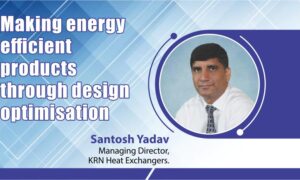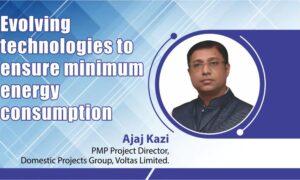We need to look at the way forward from five pillars and relook at the way we are working in the refrigeration industry.
Reimagining the future of refrigeration industry in India Why and the how of it and why do we have to reimagine the future of refrigeration! How it is kind of getting a lot more focus and attention in a post Covid scenario. Now, we all know that refrigeration definitely plays an important role in cold chain. When we look at it from a refrigeration point of view, we are also aware that the COP 26 is concluding and a lot of deliberations are happening on climate and India has taken a stand while it sounds that 2070 is a long way off.
Sustainable development goals
India has also the sustainable development goals that we are looking at meeting them by 2030. There are 17 Sustainable Development Goals. There are about eight sustainable development goals that the refrigeration industry has a direct role to play. And these eight sustainable development goals are in a large way related to agriculture and food. If you look at a Zero Hunger kind of a situation, having good health, having clean and affordable energy, the impact of climate, I mean, these are some of the things that one need to read.
Refrigeration as an industry has a direct impact on all these sustainable development goals and how India is going to achieve the sustainable development goals. The ‘Farm to Fork’, I would actually call it the ‘Fork to Farm’. We have to connect the fork to the farm and not the farm to the fork, because when we know what is required at the fork that can be produced at the farm. And today, we are doing the other way around; we are producing at the farm and trying to push it onto the fork. We do not exactly know whether the fork is needed. Keeping that part aside, in India, we have a huge nutrition deficit. At the same time, we have a lot of loss happening in the very perishables.
The third one is the medicine, medical and the pharma industry where the role that cold chain plays needs more emphasis, because in the last 18 months, we have understood it’s kind of importance. And when we look at the current scenario, a lot more cold chain has happened. The overall penetration of this sector in India is close to 7 percent. Even in an economy like China, it was close to 30 percent. In a developed world, it is probably 60 to 70 percent; everything needs to move through the cold chain. It depends on where the demand is. And, if the demand is at a distant location, it needs to move through a whole chain to ensure that the perishable item retains its quality. Increasingly, because of urbanisation in the country, the producers and the consumers are at different locations. And that’s the reason for us to bring in the aspect of cold chain otherwise; in an earlier era when everybody was living closer to the producers you never needed cold chain because they were always closer to the place where it was produced.
We also need a cold chain to ensure that fresh perishables are available on the plate because we all know that fresh is better than frozen for consumption. So we need to reimagine the refrigeration industry in terms of understanding how we can get more and more fresh produce onto our plates! What is the technology that is needed? What is the awareness that is needed, what are the skill levels that are needed?
Moreover, looking at the opportunity side in terms of pack houses or reefer vehicles or cold storage; it is not just the opportunity that is available, but there is need to look at it from the aspect of the cooling action plan. This opportunity is going to put a huge pressure on the energy demand of the country; put huge pressure on the cooling demand of the country; put a huge demand on the refrigerants that are required for this.
All of these things at the end of the day are not good for the climate, because they are going to add more heat into the climate. So we need to understand from an industrial point of view, what is it that we can do? Where we can reduce the energy demand, where we can reduce the refrigerant demand, where we can look at alternative energy requirements? And is there energy that is being lost that can be combined? Do we always need to depend on a grid for energy requirements? And that throws a huge opportunity for the sector in India. This is an opportunity that is going to come up for a lot of start-ups. For a lot of entrepreneurs, for students who are right now coming out, that is the opportunity that they can capitalise on because we all talk of electrification from a vehicles point of view. But electrification and energy storage is an opportunity that can be capitalised in the cold chain sector.
Today, a lot of the dairy sector is available, where bulk milk chillers used in rural areas depend on diesel gensets. So, there is an opportunity for renewable energy along with energy storage and electrification to make a paradigm shift and move away from diesel gensets because it carries an impact on the climate. That’s the kind of opportunity in the sector today.
We need to look at newer ways of working within the sector rather than decide that okay; this is the way things have worked. And this is the way that things will work. We need to look at how we make the paradigm shift. So looking at this, what is the way forward that I believe that the refrigeration industry should be imagined?
Five pillars
First pillar is sustainability pillar, where we need to look at integrating renewable and energy storage into the sector. Secondly, we need to look at low GWP and natural refrigerants as an alternative to existing technologies available in some places. In a lot of large cultures, we already use natural refrigerants. But in the commercial refrigeration industry, we are still working on a lot of HFCs.
The third aspect within sustainability is business model innovation. Because the current business models are enabling us to make a paradigm shift, make that multiplier effect in the industry. While it is a sunrise industry, we can’t expect the sunrise industry to keep rising for the next decade. We need to move fast, we need to see the sun rising and come up really high. And for that business, financial model innovation is going to play a very key role.
Second pillar is efficiency, where we already have a lot of cooling and heating technologies. And in both of these places, there is a lot of energy that is lost. So sector integration is going to play a very important role in the cold chain. How do we use the heat that is coming out of refrigeration to produce probably hot water that we need elsewhere in the same establishment.
The second aspect on efficiency is on stakeholder development while we have some real stalwarts, like we are already there on the panel, who know what efficiency is and have been the driving forces. We need many, many more people here, the consultants, the contractors, the system integrators, the students, we need a multiplier of these people to understand what efficiency is, and they are driving it in their daily life and that is the key. And to me, magazines like Thermal Control Business update and panel discussions like this are things that will help us move in that direction.
Third pillar is skill and capacity development, which was touched upon a little bit. But we definitely need a lot more effort here. We need skilled technicians in this space. So there is a lot of effort that needs to be done here. And I’m happy that a society like ISHRAE is doing such good work that we need to further focus on this.
Fourth pillar is policy directives, where at this point in time, while we have guidelines for buildings like ECBC, we also need guidelines for cold storages and package houses and they need to be measured while on commercial refrigeration for deep freezers. We are getting five stars, but how do you bring in something like a label or a star rating for larger cold storages! And how can you drive that at a ground level! Is there a scope for incentivising people who are at are adapting these guidelines? There are a lot of policies and subsidies available from the government to establish cold storages, but can we link them up with some form of energy efficiency and sustainability so that people will more willingly adapt sustainability in that direction? When technology develops; you also need to develop newer standards so that people can easily use those technologies because some of the technologies that can come in could be technologies which will need the right safety standards in place.
The last and fifth pillar belongs to standards. They are already available for natural refrigerants like ammonia, where ISHRAE has worked very closely with industry and the Bureau of Indian standards to develop the standard. Today, it is important that standards be disseminated and communicated to stakeholders because stakeholders should know that a standard is available to them which they can use and be safe to use natural refrigerants. So, we need to understand how we can do that.
Way forward
IoT and AI is definitely the way forward, we are seeing a lot more traction on this at least as a company. Today, we need not sell these products; our customers are asking us more and more of how they can work on their cold store or their cold chain solution remotely. So it’s becoming more demand driven. We need to look at the way forward from these five pillars and relook at the way we are working in the refrigeration industry. When the people are passing out, they should look at joining this industry as it will help them not only reach sustainable development goals, but also help make the planet a safer place to live in. That is the direction we should look at. And if we aim for the sky, I am sure we will reach them.
Cookie Consent
We use cookies to personalize your experience. By continuing to visit this website you agree to our Terms & Conditions, Privacy Policy and Cookie Policy.















